Install the app
How to install the app on iOS
Follow along with the video below to see how to install our site as a web app on your home screen.
Note: This feature may not be available in some browsers.
You are using an out of date browser. It may not display this or other websites correctly.
You should upgrade or use an alternative browser.
You should upgrade or use an alternative browser.
Ukrainan sodan havainnot ja opetukset
- Viestiketjun aloittaja Mustaruuti
- Aloitus PVM
"Venäjä hyökkäsi Ukrainaan lähes vuosi sitten. Ilta-Sanomat listaa nyt kymmenen tärkeintä taistelua, jotka ovat vaikuttaneet sodan kulkuun. Listalle nousevat niin Käärmesaaren taistelu kuin ”suorastaan hulluna” pidetty vastahyökkäys."

 www.is.fi
www.is.fi

Härski tihutyö pelasti Kiovan, kenraalin ”hullu” suunnitelma yllätti omatkin – nämä olivat Ukrainan sotavuoden 10 ratkaisutaistelua
Venäjä hyökkäsi Ukrainaan lähes vuosi sitten. Ilta-Sanomat listaa nyt kymmenen tärkeintä taistelua, jotka ovat vaikuttaneet sodan kulkuun. Listalle nousevat niin Käärmesaaren taistelu kuin ”suorastaan hulluna” pidetty vastahyökkäys.
Panssari Salama
Respected Leader
Russia’s New Offensive in Ukraine Exposes Blunders, Poor Training
Heavy losses on the battlefield point to an ineffective Russian command structure
Lahjalinkki maksumuurin taakse:
Russia’s New Offensive in Ukraine Exposes Blunders, Poor Training
Recent fighting in Ukraine has exposed chronic problems in Russia’s command and control structure as Moscow continues to struggle in executing large-scale mechanized assaults, Western officials say.
Erään väijytyksen analyysi
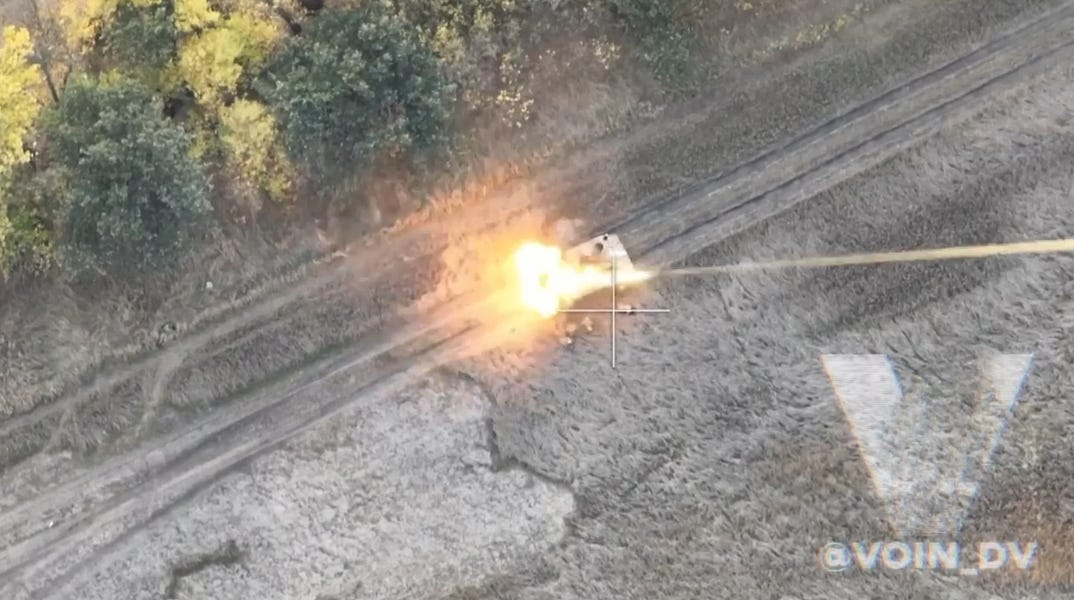
 ryanmcbeth.substack.com
ryanmcbeth.substack.com

Analysis of the Ukrainian M113 Ambush
Watch now (12 min) | The crew did some things right but still got killed. Here is how.
Tänne jatkot Himars ihmettelystä. Ne tähtäs munille, mutta osui jalkaan kolmen betonin läpi.On ne kyllä tarkkoja vehkeitä: Kymmenien kilometrien päästä suoraan Juhaa jalkaan.
Itselleni oli hieman yllätys raketin läpäisyvoima, kun sytytin ei toimi. Kalikkahan tuli aivan kohtisuoraan alas ja todella kovaa, kun meni vielä metrin perustuksiin kellarissa olleen hetekan läpi läpäistyään 3 betonista välikattoa.
tulikomento
Supreme Leader
John Hilly
Respected Leader
Ukrainan kansalliskaartin Omega-erikoisjoukkojen sotilas kertoo virolaiselle Postimees -lehdelle hetkestä, jolloin Venäjä käynnisti hyökkäyksen Ukrainaan.
Ensimmäiset ohjukset iskeytyivät Omegan Kiovan lähellä sijaitsevaan tukikohtaan hieman ennen viittä aamuyöllä. Sotilaan mukaan hyökkääjä oli valinnut kohteet tarkasti. Lisää:
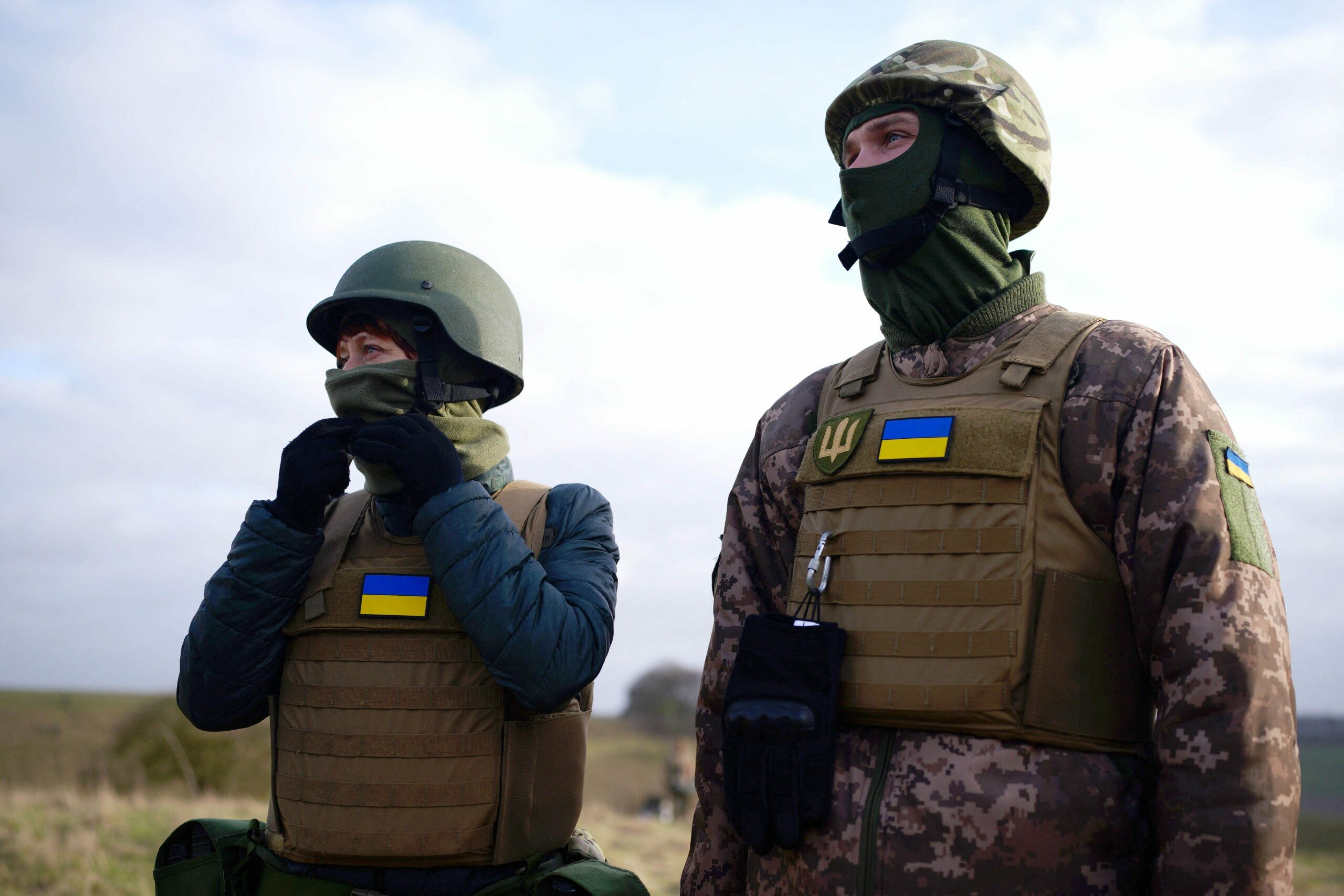
Ensimmäiset ohjukset iskeytyivät Omegan Kiovan lähellä sijaitsevaan tukikohtaan hieman ennen viittä aamuyöllä. Sotilaan mukaan hyökkääjä oli valinnut kohteet tarkasti. Lisää:

Kiovan puolustaja: Näin Venäjän agentit merkkasivat kohteita ennen hyökkäystä | Verkkouutiset
Erikoisjoukkojen sotilaan mukaan pääkaupungissa hiiviskeli paljon epäilyttäviä ihmisiä.
www.verkkouutiset.fi
Antares
Respected Leader
Sotaa tarkasti seuraavan Tatarigami_UA twitter-tilin kirjoitus Wagnerin käyttämistä taktiikoista: LÄHDE
Ei ole ensimmäinen kerta kun näistä wagnerilaisten (ja arvatenkin myös muiden, VDV ja merijalkaväki tulevat ensimmäisenä mieleen) käyttämistä taktiikoista ja niiden torjunnasta on kirjoitettu tässä ketjussa:
1) ukrainalaisten kuvaus sekä torjuntakeinoja: LINKKI
2) venäläisen lähteen kirjoitus: LINKKI
Hyvä pohtia tykönään, miltä tällainen hyökkäys näyttää ja mitkä keinot siihen purevat.
You don't hear as much about the advancement of regular russian brigades, but you see reports about Wagner advancing in certain areas. While it's true that it's achieved due to extrajudicial executions and irrational losses, the situation is a little bit more complex
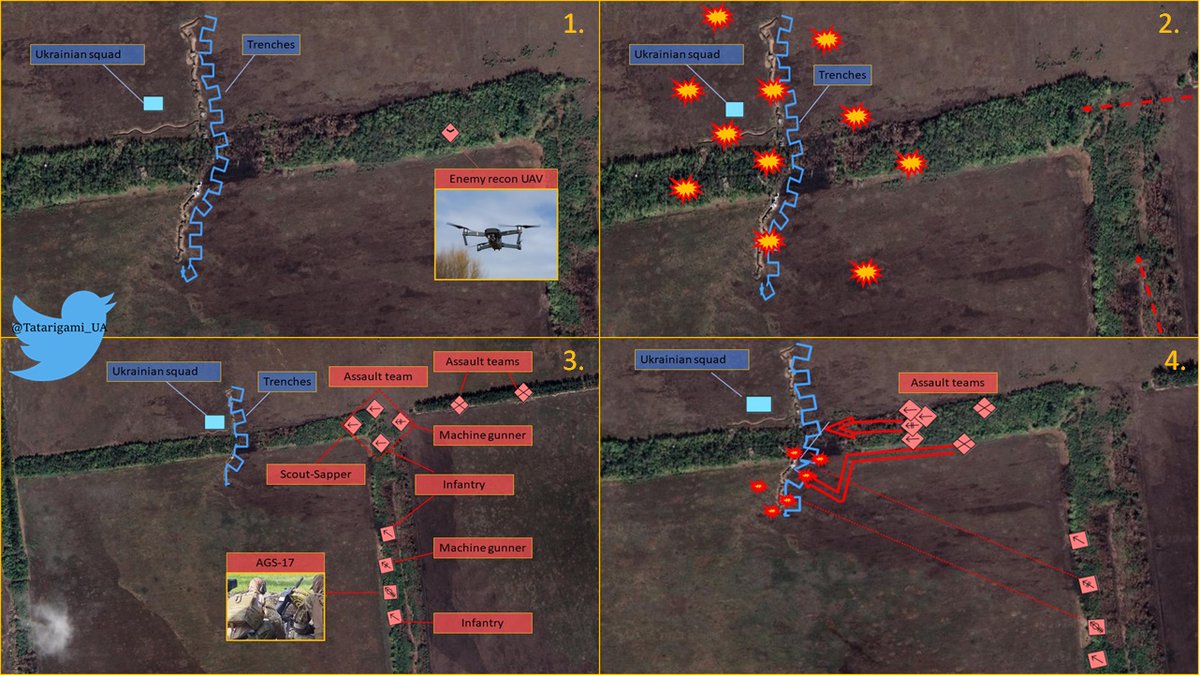
One of the biggest threats posed by Wagner is that they have much more freedom in assaults than regular forces, whose officers must follow rules defined by military regulations, based on the soviet military doctrine. Let's take a closer look at Wagner's tactics.
Let's imagine a situation where a Ukrainian squad, possibly 9 people, is tasked with securing a tree line in trenches - a quite common occurrence in this war.
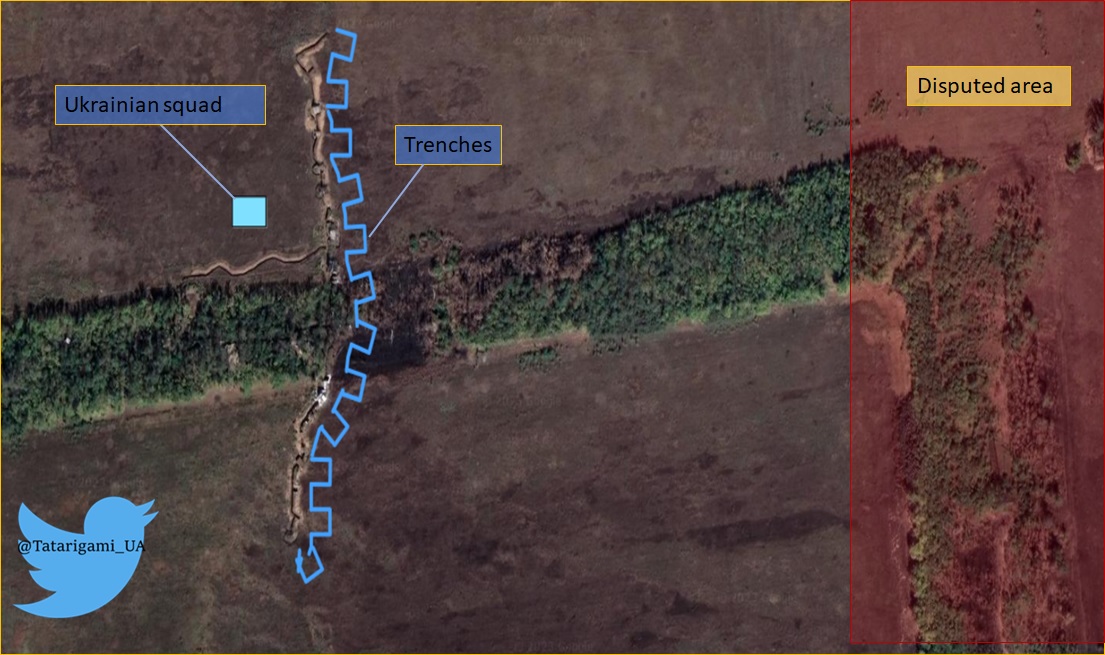
Before the attack, the enemy dispatches a quadcopter to gather intelligence about defenders - the number of people, their armament, trench, and dugout disposition. Based on this information, wagnerites would adjust the number of assault teams, to have a numerical advantage.
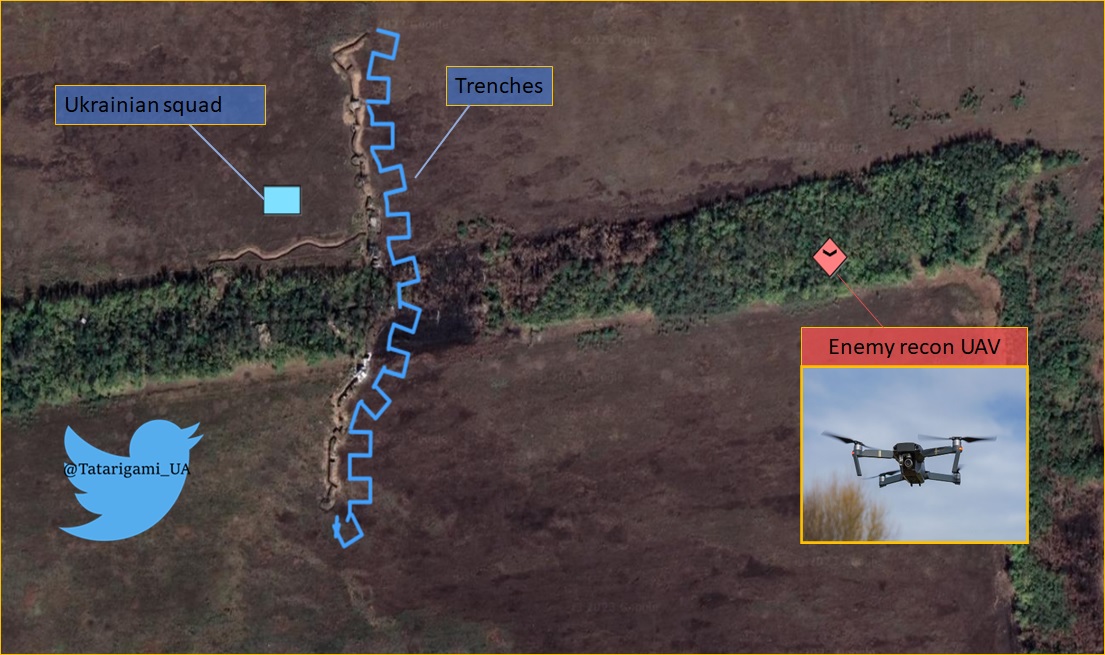
Once targets are determined, the enemy artillery or mortars shell trenches, sometimes for a few days, suppressing the ability of defenders to fight or observe. Covered by this fire, the assault teams start moving closer to the trenches without any significant resistance.

Wagnerites usually break down into small assault teams consisting of 3-4 people. The first team is usually led by a "scout" who is tasked to observe and locate mined areas ahead. He is followed by two regular riflemen and a machine gunner.

At the same time, they are usually also covered by the "support" team, armed either with mortar, or automatic grenade launchers such as AGS-17 or AGS-30. Given that not every assault group has one, they can be replaced with a few soldiers armed with RPG-7s instead.
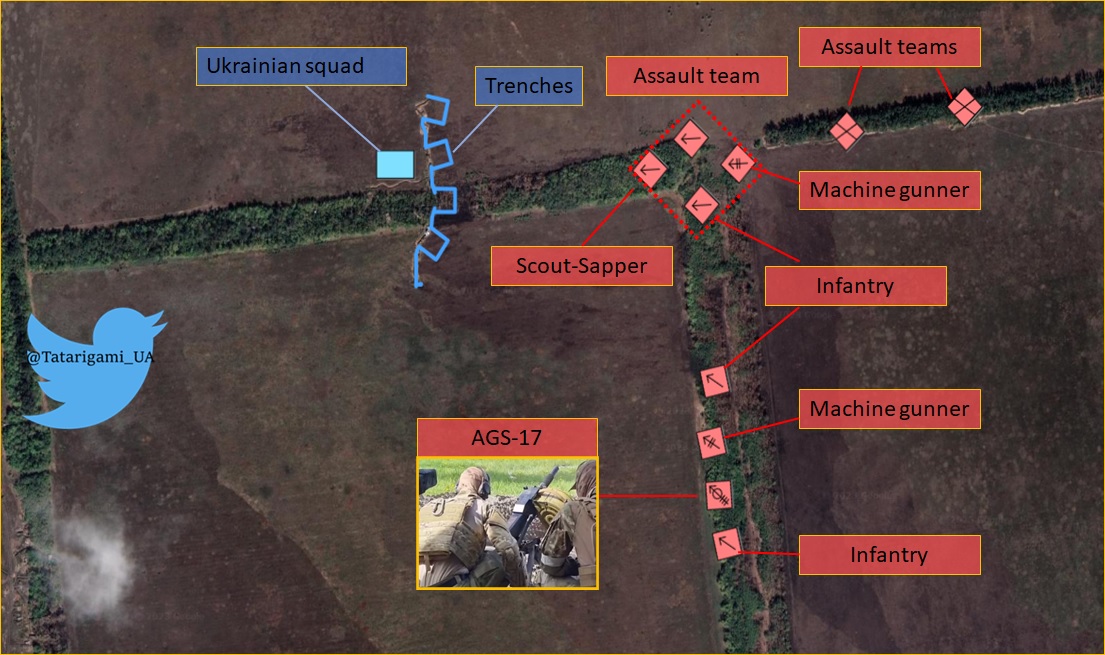
Once the artillery fire ends, before defenders can take any measures, the support team armed with AGS or RPGs and a machine gun, opens suppressive fire, allowing assault teams to move even closer to trenches. They usually try to engage and outflank the defenders.
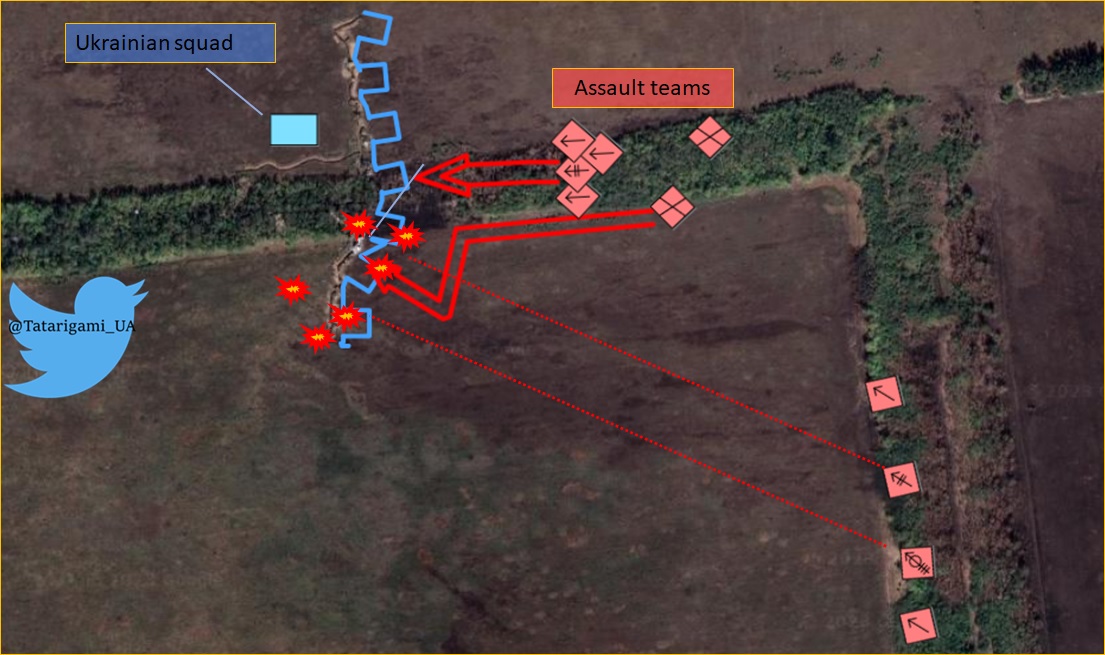
Once close enough to the trenches, the enemy uses hand grenades to cause damage and then assaults the trenches.
I would like to emphasize that this is a generalization, because situations may vary, so treat this just as a general summary.
Are there ways to fight this? Yes, there are plenty of ways to counter such assaults with minimal losses, however, I would like to focus on what mistakes should be avoided.
Since I haven't been to the Bakhmut area myself, I spoke to multiple people from a soldier to a lieutenant colonel instead. To exclude personal anecdotes, I included only the most commonly mentioned issues that hinder the ability of units to defend positions effectively:
- Some units are not allowed to determine armament for themselves based on their needs. Their resources are limited based on regulations, papers, and bureaucracy rather than tactical needs. It doesn’t work from the bottom to the top – mostly from the top to the bottom.
- Insufficient freedom to select defensive positions. Positions are selected by officers in a remote command center, rather than by units on the ground. Officers might avoid challenging ridiculous orders from the CC, fearing repercussions, resulting in a lack of initiative.
- Some senior officers remotely micromanage and intervene in the processes on a platoon, company, and battalion level, often worsening the situation significantly.
- Immobile units limited in weapons, tied to specific positions, deprived of maneuver, and having little leeway in actions are much easier targets for wagnerite cannon-fodder assaults, which are designed to fight against such soviet-styled defenses.
In the areas where these mistakes were avoided, units performed greatly. While the Ukrainian army improved a lot, it's not always possible to turn a colonel or a general with 30 years of soviet-style experience into a NATO-like commander by performing a 3-month course.
As Bakhmut experience shows, the system needs to be less top-to-bottom but bottom-to-top. The initiative should be encouraged. Centralized, soviet-style management should be replaced with a NATO-style leadership. To win, we need to be flexible, and adapt soon as possible
-
Ketjun kommenteissa oli kysymys: Were the UA armies in Vuhledar using such NATO defense tactics?
Johon hän vastasi näin: LÄHDE
Yes, it wasn’t perfect but brigade in general had much more flexibility in terms of decisions and ability to make necessary maneuvers. Ability of teams/squads/platoons to determine the best course of action based on tactical situation played a positive role.

One of the biggest threats posed by Wagner is that they have much more freedom in assaults than regular forces, whose officers must follow rules defined by military regulations, based on the soviet military doctrine. Let's take a closer look at Wagner's tactics.
Let's imagine a situation where a Ukrainian squad, possibly 9 people, is tasked with securing a tree line in trenches - a quite common occurrence in this war.

Before the attack, the enemy dispatches a quadcopter to gather intelligence about defenders - the number of people, their armament, trench, and dugout disposition. Based on this information, wagnerites would adjust the number of assault teams, to have a numerical advantage.

Once targets are determined, the enemy artillery or mortars shell trenches, sometimes for a few days, suppressing the ability of defenders to fight or observe. Covered by this fire, the assault teams start moving closer to the trenches without any significant resistance.

Wagnerites usually break down into small assault teams consisting of 3-4 people. The first team is usually led by a "scout" who is tasked to observe and locate mined areas ahead. He is followed by two regular riflemen and a machine gunner.

At the same time, they are usually also covered by the "support" team, armed either with mortar, or automatic grenade launchers such as AGS-17 or AGS-30. Given that not every assault group has one, they can be replaced with a few soldiers armed with RPG-7s instead.

Once the artillery fire ends, before defenders can take any measures, the support team armed with AGS or RPGs and a machine gun, opens suppressive fire, allowing assault teams to move even closer to trenches. They usually try to engage and outflank the defenders.

Once close enough to the trenches, the enemy uses hand grenades to cause damage and then assaults the trenches.
I would like to emphasize that this is a generalization, because situations may vary, so treat this just as a general summary.
Are there ways to fight this? Yes, there are plenty of ways to counter such assaults with minimal losses, however, I would like to focus on what mistakes should be avoided.
Since I haven't been to the Bakhmut area myself, I spoke to multiple people from a soldier to a lieutenant colonel instead. To exclude personal anecdotes, I included only the most commonly mentioned issues that hinder the ability of units to defend positions effectively:
- Some units are not allowed to determine armament for themselves based on their needs. Their resources are limited based on regulations, papers, and bureaucracy rather than tactical needs. It doesn’t work from the bottom to the top – mostly from the top to the bottom.
- Insufficient freedom to select defensive positions. Positions are selected by officers in a remote command center, rather than by units on the ground. Officers might avoid challenging ridiculous orders from the CC, fearing repercussions, resulting in a lack of initiative.
- Some senior officers remotely micromanage and intervene in the processes on a platoon, company, and battalion level, often worsening the situation significantly.
- Immobile units limited in weapons, tied to specific positions, deprived of maneuver, and having little leeway in actions are much easier targets for wagnerite cannon-fodder assaults, which are designed to fight against such soviet-styled defenses.
In the areas where these mistakes were avoided, units performed greatly. While the Ukrainian army improved a lot, it's not always possible to turn a colonel or a general with 30 years of soviet-style experience into a NATO-like commander by performing a 3-month course.
As Bakhmut experience shows, the system needs to be less top-to-bottom but bottom-to-top. The initiative should be encouraged. Centralized, soviet-style management should be replaced with a NATO-style leadership. To win, we need to be flexible, and adapt soon as possible
-
Ketjun kommenteissa oli kysymys: Were the UA armies in Vuhledar using such NATO defense tactics?
Johon hän vastasi näin: LÄHDE
Yes, it wasn’t perfect but brigade in general had much more flexibility in terms of decisions and ability to make necessary maneuvers. Ability of teams/squads/platoons to determine the best course of action based on tactical situation played a positive role.
Ei ole ensimmäinen kerta kun näistä wagnerilaisten (ja arvatenkin myös muiden, VDV ja merijalkaväki tulevat ensimmäisenä mieleen) käyttämistä taktiikoista ja niiden torjunnasta on kirjoitettu tässä ketjussa:
1) ukrainalaisten kuvaus sekä torjuntakeinoja: LINKKI
2) venäläisen lähteen kirjoitus: LINKKI
Hyvä pohtia tykönään, miltä tällainen hyökkäys näyttää ja mitkä keinot siihen purevat.
Antares
Respected Leader
Tsekissä valmistettuja ilmatäytteisiä valemaaleja, videolla mainitaan M270-vaunu mutta arvatenkin valikoimasta löytyy myös muita:
Kuvakaappaus videon ajanhetkeltä 0:20:
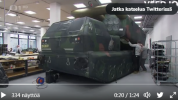
-
Sodan aikana on kuultu myös vanerista / puusta valmistetuista valemaaleista. Minun arvaus: varmasti myös vaurioituneita ja kannibalisoituja vaunuja on hinattu taistelualueelle valemaaleiksi.
Asiana tämä ei tietysti ole uusi, jos Googlaa esim. hakusanoilla "ww2 inflatable tank" niin löytyy vaikka ja mitä, esimerkiksi tämä kuva:
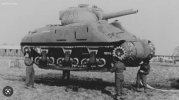
Tuoreempi versio samasta ideasta:
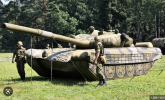
-
Voidaan toki taittaa peistä siitä, millainen valemaali on "riittävä" eli mitkä sensorit tunnistavat sen valemaaliksi ja siten se on "hyödytön".
Toisaalta Ukrainassa molemmat osapuolet käyttävät paljon siviilikäyttöön tarkoitettuja kameroilla varustettuja droneja ja UAV-lennokkeja, joten valemaalin tunnistus tapahtuu silmämääräisesti. Jos tarkastellaan lämpökameralla, sitä voi olla vaikeampi harhauttaa (tosin valemaali voidaan lämmittää elementeillä tms). Sitten on vielä eri asia, jos tiedustellaan LIDAR-satelliittilla tai tutkien avulla, niiden luulisi "näkevän ilmapallojen läpi" mikä paljastaisi valemaalit, mutta voi toki miettiä, saavatko kaikki yksiköt tätä tiedusteludataa 100% ja reaaliajassa? Ehkä arvokkaita ohjuksia tuhlataan valemaaleihin, jos tiedustelu ja tiedonvälitys tökkii?
Ei näillä toki sotaa voiteta ja vallata menetettyjä asemia takaisin, mutta yksi yksityiskohta muiden joukossa.
Kuvakaappaus videon ajanhetkeltä 0:20:

-
Sodan aikana on kuultu myös vanerista / puusta valmistetuista valemaaleista. Minun arvaus: varmasti myös vaurioituneita ja kannibalisoituja vaunuja on hinattu taistelualueelle valemaaleiksi.
Asiana tämä ei tietysti ole uusi, jos Googlaa esim. hakusanoilla "ww2 inflatable tank" niin löytyy vaikka ja mitä, esimerkiksi tämä kuva:

Tuoreempi versio samasta ideasta:

-
Voidaan toki taittaa peistä siitä, millainen valemaali on "riittävä" eli mitkä sensorit tunnistavat sen valemaaliksi ja siten se on "hyödytön".
Toisaalta Ukrainassa molemmat osapuolet käyttävät paljon siviilikäyttöön tarkoitettuja kameroilla varustettuja droneja ja UAV-lennokkeja, joten valemaalin tunnistus tapahtuu silmämääräisesti. Jos tarkastellaan lämpökameralla, sitä voi olla vaikeampi harhauttaa (tosin valemaali voidaan lämmittää elementeillä tms). Sitten on vielä eri asia, jos tiedustellaan LIDAR-satelliittilla tai tutkien avulla, niiden luulisi "näkevän ilmapallojen läpi" mikä paljastaisi valemaalit, mutta voi toki miettiä, saavatko kaikki yksiköt tätä tiedusteludataa 100% ja reaaliajassa? Ehkä arvokkaita ohjuksia tuhlataan valemaaleihin, jos tiedustelu ja tiedonvälitys tökkii?
Ei näillä toki sotaa voiteta ja vallata menetettyjä asemia takaisin, mutta yksi yksityiskohta muiden joukossa.
Satchel
Kapteeni
Valemaali on onnistunutjo jos sen tunnistamiseksi valemaaliksi käytetään aikaa ja resurssia. Omilla pyörillä tai teloilla liikkuvan tykistön tai rakentinheittimistön tuhoaminen vaatii tehokasta ja nopeaa tiedustelua ja tulenavausta. Valemaali onnistuu jos se tuhotaan, mutta myös jos tietoisuus valemaaleista saa ryssän käyttämään enemmän aikaa varmisteluun.Tsekissä valmistettuja ilmatäytteisiä valemaaleja, videolla mainitaan M270-vaunu mutta arvatenkin valikoimasta löytyy myös muita:
Kuvakaappaus videon ajanhetkeltä 0:20:
Katso liite: 74263
-
Sodan aikana on kuultu myös vanerista / puusta valmistetuista valemaaleista. Minun arvaus: varmasti myös vaurioituneita ja kannibalisoituja vaunuja on hinattu taistelualueelle valemaaleiksi.
Asiana tämä ei tietysti ole uusi, jos Googlaa esim. hakusanoilla "ww2 inflatable tank" niin löytyy vaikka ja mitä, esimerkiksi tämä kuva:
Katso liite: 74264
Tuoreempi versio samasta ideasta:
Katso liite: 74265
-
Voidaan toki taittaa peistä siitä, millainen valemaali on "riittävä" eli mitkä sensorit tunnistavat sen valemaaliksi ja siten se on "hyödytön".
Toisaalta Ukrainassa molemmat osapuolet käyttävät paljon siviilikäyttöön tarkoitettuja kameroilla varustettuja droneja ja UAV-lennokkeja, joten valemaalin tunnistus tapahtuu silmämääräisesti. Jos tarkastellaan lämpökameralla, sitä voi olla vaikeampi harhauttaa (tosin valemaali voidaan lämmittää elementeillä tms). Sitten on vielä eri asia, jos tiedustellaan LIDAR-satelliittilla tai tutkien avulla, niiden luulisi "näkevän ilmapallojen läpi" mikä paljastaisi valemaalit, mutta voi toki miettiä, saavatko kaikki yksiköt tätä tiedusteludataa 100% ja reaaliajassa? Ehkä arvokkaita ohjuksia tuhlataan valemaaleihin, jos tiedustelu ja tiedonvälitys tökkii?
Ei näillä toki sotaa voiteta ja vallata menetettyjä asemia takaisin, mutta yksi yksityiskohta muiden joukossa.
Antares
Respected Leader
Pari kuvaa Ukrainan käyttämistä valemaaleista, kiitokset käyttäjälle RKSTAK kuvista. Hän lisäsi nämä "Ukrainan sodan seuranta" -ketjuun, mistä poimin ne tänne. Hän kirjoitti viestissään näin: LÄHDE
Ukrainan valemaaleja Himars ja M777
Hyvältä näyttää


-
Sodan aikana on saatu nauraa Venäjän MoD tiedotteille, jonka mukaan ovat tuhonneet Ukrainan ilmavoimat, panssarivoimat, HIMARS/M270-laitteet yms. moninkertaisesti. Mukana on arvatenkin ryssälle tyypillistä raporttien kaunistelua, mikä johtaa pitkässä juoksussa siihen että on tuhottu suuremmat määrät kalustoa kuin mitä vastapuolella on ollutkaan MUTTA arvaan että osa näistä "tuhotuiksi raportoiduista" on erilaisia valemaaleja.
Mahdoton toki seuloa, mikä osa on valemaaleja, mikä oikeita osumia ja minkä verran näiden päällä on liioittelua.
MUOKKAUS: yksi lähde kuville:
Ukrainan valemaaleja Himars ja M777
Hyvältä näyttää
-
Sodan aikana on saatu nauraa Venäjän MoD tiedotteille, jonka mukaan ovat tuhonneet Ukrainan ilmavoimat, panssarivoimat, HIMARS/M270-laitteet yms. moninkertaisesti. Mukana on arvatenkin ryssälle tyypillistä raporttien kaunistelua, mikä johtaa pitkässä juoksussa siihen että on tuhottu suuremmat määrät kalustoa kuin mitä vastapuolella on ollutkaan MUTTA arvaan että osa näistä "tuhotuiksi raportoiduista" on erilaisia valemaaleja.
Mahdoton toki seuloa, mikä osa on valemaaleja, mikä oikeita osumia ja minkä verran näiden päällä on liioittelua.
MUOKKAUS: yksi lähde kuville:
Viimeksi muokattu:
Antares
Respected Leader
Otetaan myös tämä linkki talteen: LÄHDE
February 23, 2023 2:09 am
-
Sodan ensimmäinen vuosipäivä on huomenna, joten nähtäneen vastaavia "aikajana" kirjoituksia eikä mikään näistä tietysti voi olla täydellinen, koska yhden vuoden tapahtumien puristaminen tällaiseen artikkeliin on mahdoton tehtävä. Silti paras ottaa talteen, koska joku joka on aloittanut sodan kulun seuraamisen myöhemmin voi olla kiinnostunut aikaisemmista tapahtumista. Samalla olen huomannut, että sodan jatkuessa itsekin alkaa unohtamaan, milloin mikäkin tapahtuma tapahtui (Venäjän vetäytyminen Kiovan seudulta, Moskvan upotus, Mariupolin lopullinen valtaaminen, Severodonetskin valtaus yms.). Toki nämä löytää nopealla haulla, MUTTA pitää tietysti tietää ensin että tällaiset tapahtumat tapahtuivat sodan aikana.
Tämä ISW:n (Institute for the Study of War) sivu on myös erinomainen lähde, jos haluaa lukea tarkemmin eri päivien tapahtumista. Sivulla on lyhyt yhteenveto ja sen kaverina linkki heidän varsinaiseen raporttiinsa ko. päivän osalta, joka sisältää myös kartan - huomaa että vuoden 2022 raportit on siirretty omalle sivulleen, sinne on oma linkkinsä. ISW:n raportteja on toisinaan haukuttu ns. huhupuheita toistaviksi eivätkä kartatkaan välttämättä ole 100% oikein eri aikoina, mutta sanoisin että riittävän hyvä yleiskuva. Ryssä toki tekee sodan aikana parhaansa jotta eri lähteiden uskottavuus kärsisi. Sodan aikana on nähty yhdenlainen OSINT-tilien (Open Source INTelligence) räjähdys, joten sodan kulun seurantaan ja karttojen julkaisuun on moni muitakin lähteitä.
Linkki ISW:n seurantaan: LINKKI
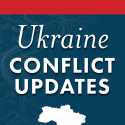
This page collects ISW and CTP's updates on the conflict in Ukraine. In late February 2022, ISW began publishing daily synthetic products covering key events related to renewed Russian aggression against Ukraine. These Ukraine Conflict Updates replaced ISW’s previous “Indicators and Thresholds for Russian Military Operations in Ukraine and/or Belarus,” which we maintained from November 12, 2021, through February 17, 2022.
This list also includes prominent warning alerts that ISW and CTP launched beyond our daily Ukraine Conflict Updates. These products addressed critical inflection points as they occurred.
Click here to see ISW's interactive map of the Russian invasion of Ukraine. This map complements the static control-of-terrain maps that ISW daily produces with high-fidelity and, where possible, street-level assessments of the war in Ukraine.
Click here to see ISW's interactive timeline of the invasion. This high-definition interactive map is resource intensive. The performance and speed of the map correlate with the strength of your hardware.
Timeline of Russia's all-out war in Ukraine, month by month
by Thaisa SemenovaFebruary 23, 2023 2:09 am
-
Sodan ensimmäinen vuosipäivä on huomenna, joten nähtäneen vastaavia "aikajana" kirjoituksia eikä mikään näistä tietysti voi olla täydellinen, koska yhden vuoden tapahtumien puristaminen tällaiseen artikkeliin on mahdoton tehtävä. Silti paras ottaa talteen, koska joku joka on aloittanut sodan kulun seuraamisen myöhemmin voi olla kiinnostunut aikaisemmista tapahtumista. Samalla olen huomannut, että sodan jatkuessa itsekin alkaa unohtamaan, milloin mikäkin tapahtuma tapahtui (Venäjän vetäytyminen Kiovan seudulta, Moskvan upotus, Mariupolin lopullinen valtaaminen, Severodonetskin valtaus yms.). Toki nämä löytää nopealla haulla, MUTTA pitää tietysti tietää ensin että tällaiset tapahtumat tapahtuivat sodan aikana.
Tämä ISW:n (Institute for the Study of War) sivu on myös erinomainen lähde, jos haluaa lukea tarkemmin eri päivien tapahtumista. Sivulla on lyhyt yhteenveto ja sen kaverina linkki heidän varsinaiseen raporttiinsa ko. päivän osalta, joka sisältää myös kartan - huomaa että vuoden 2022 raportit on siirretty omalle sivulleen, sinne on oma linkkinsä. ISW:n raportteja on toisinaan haukuttu ns. huhupuheita toistaviksi eivätkä kartatkaan välttämättä ole 100% oikein eri aikoina, mutta sanoisin että riittävän hyvä yleiskuva. Ryssä toki tekee sodan aikana parhaansa jotta eri lähteiden uskottavuus kärsisi. Sodan aikana on nähty yhdenlainen OSINT-tilien (Open Source INTelligence) räjähdys, joten sodan kulun seurantaan ja karttojen julkaisuun on moni muitakin lähteitä.
Linkki ISW:n seurantaan: LINKKI
UKRAINE CONFLICT UPDATES
Aug 15, 2022 - Press ISW
This page collects ISW and CTP's updates on the conflict in Ukraine. In late February 2022, ISW began publishing daily synthetic products covering key events related to renewed Russian aggression against Ukraine. These Ukraine Conflict Updates replaced ISW’s previous “Indicators and Thresholds for Russian Military Operations in Ukraine and/or Belarus,” which we maintained from November 12, 2021, through February 17, 2022.
This list also includes prominent warning alerts that ISW and CTP launched beyond our daily Ukraine Conflict Updates. These products addressed critical inflection points as they occurred.
Click here to see ISW's interactive map of the Russian invasion of Ukraine. This map complements the static control-of-terrain maps that ISW daily produces with high-fidelity and, where possible, street-level assessments of the war in Ukraine.
Click here to see ISW's interactive timeline of the invasion. This high-definition interactive map is resource intensive. The performance and speed of the map correlate with the strength of your hardware.
Click here to read about the methodology behind ISW and CTP's mapping of this conflict.
Click here to see our collection of reports from 2022.Antares
Respected Leader
Sodan aikana kumpikin osapuoli on käyttänyt panssarivaunuja epäsuorana tykistönä, mikä on kerännyt haukkuja. Väärä ase tähän käyttöön, moni on sanonut. Tässä videolla venäläinen kertoo syitä, miksi näin toimitaan:
Russian tanks in artillery mode. Why?
1. scared of Ukrainian ATGMs
2. protected from Ukrainian drone recce and arty
3. APFSDS/HEAT projectiles strongly gouge/groove the main gun from the inside
4. HE don’t groove the gun that much
Väittää että HE-kranaatti ei kuluta putkea niin paljon kuin APFSDS/HEAT. En ole panssarisotamies, joten en näistä tiedä. Ehkä totta, ehkä ei?
Joka tapauksessa syystä tai toisesta molemmat kokevat että tämä ei ole vaunujen tuhlausta. Oletan että tuotto/panos -suhde on "riittävä", tuskin tätä muuten harrastettaisiin? Tai ehkä molemmat ovat väärässä? Ei sekään ole mahdotonta. Muistan kuulleeni että Ukraina olisi käyttänyt vaunuja tällä tavoin jo 2014-2015 sodan aikana ja tästä syystä tämä kuvio olisi hierottu hyvin sujuvaksi (tulenjohto, kommunikaatio, joukkojen yhteistyö), kun taas Venäjä ja "sen kumppanit" olisivat vasta alkaneet harjoittelemaan tätä tämän tuoreen sodan myötä (toki "harjoitteluaikaa" on ollut nyt vuoden verran).
-
Tässä myös tuore juoru yhdestä "uudesta käänteestä" tämän sodan osalta: väitetysti Venäjä olisi käyttänyt kauko-ohjattuja panssaroituja ajoneuvoja, jotka lastattu räjähteillä. MT-Lb mainitaan nimeltä:
Kertoo mielestäni osaltaan vahvasta puolustuksesta, josta ei päästä läpi. Pakko kokeilla "uusia temppuja", mutta melkoista tuhlausta tämä on mielestäni. Toki ei menetetä jalkaväkeä, mutta panssaroitu tela-ajoneuvo menetetään. ISIS ja muut käyttivät Lähi-Idässä henkilöautoja ja kuorma-autoja, mutta siinä meni aina vähintään kuljettaja mukana. VBIED nimeltään eli Vehicle-Borne Improvised Explosive Device. Ukraina isku Kerchin sillalle tehtiin räjähdekuormalla lastatulla puoliperävaunuyhdistelmällä, mutta ei ole saatu vahvistusta, oliko kuljettaja juonessa mukana vai ei. Joka tapauksessa silta ja samalla hyvin tärkeä huoltoreitti on ollut iskun myötä poikki monta kuukautta.
Russian tanks in artillery mode. Why?
1. scared of Ukrainian ATGMs
2. protected from Ukrainian drone recce and arty
3. APFSDS/HEAT projectiles strongly gouge/groove the main gun from the inside
4. HE don’t groove the gun that much
Väittää että HE-kranaatti ei kuluta putkea niin paljon kuin APFSDS/HEAT. En ole panssarisotamies, joten en näistä tiedä. Ehkä totta, ehkä ei?
Joka tapauksessa syystä tai toisesta molemmat kokevat että tämä ei ole vaunujen tuhlausta. Oletan että tuotto/panos -suhde on "riittävä", tuskin tätä muuten harrastettaisiin? Tai ehkä molemmat ovat väärässä? Ei sekään ole mahdotonta. Muistan kuulleeni että Ukraina olisi käyttänyt vaunuja tällä tavoin jo 2014-2015 sodan aikana ja tästä syystä tämä kuvio olisi hierottu hyvin sujuvaksi (tulenjohto, kommunikaatio, joukkojen yhteistyö), kun taas Venäjä ja "sen kumppanit" olisivat vasta alkaneet harjoittelemaan tätä tämän tuoreen sodan myötä (toki "harjoitteluaikaa" on ollut nyt vuoden verran).
-
Tässä myös tuore juoru yhdestä "uudesta käänteestä" tämän sodan osalta: väitetysti Venäjä olisi käyttänyt kauko-ohjattuja panssaroituja ajoneuvoja, jotka lastattu räjähteillä. MT-Lb mainitaan nimeltä:
Kertoo mielestäni osaltaan vahvasta puolustuksesta, josta ei päästä läpi. Pakko kokeilla "uusia temppuja", mutta melkoista tuhlausta tämä on mielestäni. Toki ei menetetä jalkaväkeä, mutta panssaroitu tela-ajoneuvo menetetään. ISIS ja muut käyttivät Lähi-Idässä henkilöautoja ja kuorma-autoja, mutta siinä meni aina vähintään kuljettaja mukana. VBIED nimeltään eli Vehicle-Borne Improvised Explosive Device. Ukraina isku Kerchin sillalle tehtiin räjähdekuormalla lastatulla puoliperävaunuyhdistelmällä, mutta ei ole saatu vahvistusta, oliko kuljettaja juonessa mukana vai ei. Joka tapauksessa silta ja samalla hyvin tärkeä huoltoreitti on ollut iskun myötä poikki monta kuukautta.
Viimeksi muokattu:
Panssari Salama
Respected Leader
Sodan vuosipäivä huomenna, tässä erinomaisen suositeltava artikkeli sodan ensimmäisestä vuodesta. Ei ollut ainakaan itselläni maksumuurin takana joten otetaan talteen.
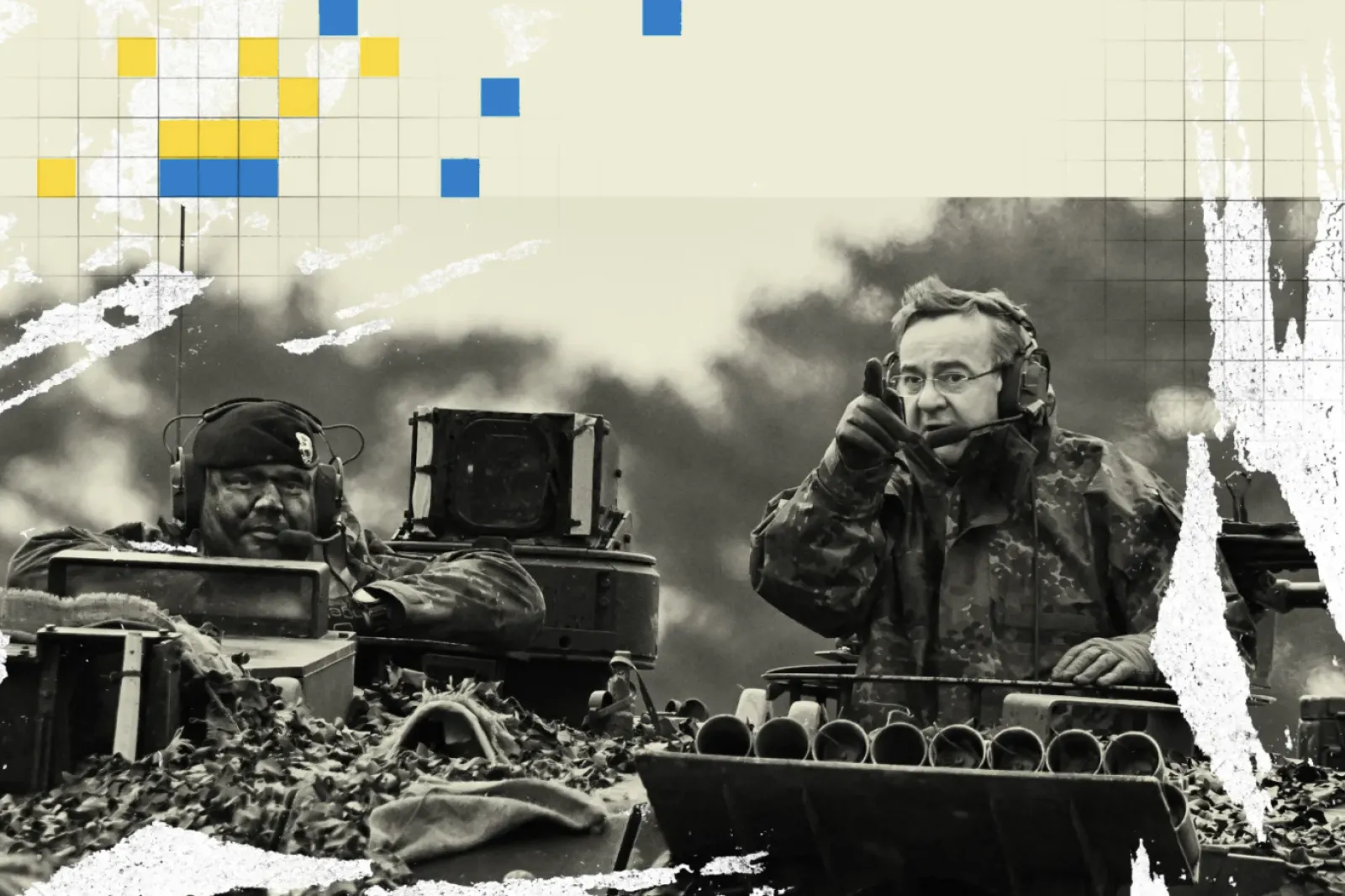
German Defense Minister Boris Pistorius visiting tanks that will be sent to Ukraine, Augustdorf, Germany, February 2023
Benjamin Westhoff / Reuters / Foreign Affairs illustration
Sign in and save to read later
Print this article
Send by email
Share on Twitter
Share on Facebook
Share on LinkedIn
Page url
Get Citation
Request Reprint Permissions
This article is part of an ongoing series examining what a year of war in Ukraine has revealed.
The Western response to Russia’s invasion of Ukraine has been less a problem of strategy than of tactics and execution. After one year of fighting, the basic idea—support Ukraine and defeat Russia—has held up well; the implementation has not. That holds especially true for the United States.
Successful statecraft has much in common with the concept of aerial combat formulated by twentieth-century U.S. Air Force pilot and military thinker John Boyd. From his experience in the Korean War and later studies, Boyd concluded that fighter pilots engage in combat in a four-stage cycle: a pilot observes what is going on, orients himself to the environment, decides what to do, and acts accordingly. The tighter the loop—the quicker and more efficiently each stage is mastered—the greater the chance of success, and, indeed, survival.
Sign Up
Throughout the war in Ukraine, the West has excelled at the first stage of Boyd’s cycle. It has closely tracked the Russian buildup around Ukraine. And beyond the first stage, the West has generally done the right thing—supporting Ukraine and sanctioning Russia. But again and again, it has taken far too long to execute, lacking urgency and agility. The path from observation and understanding to decision and action has been painfully slow. Along the way, there have been many missed opportunities to seriously weaken Russia and enable Ukraine to win. What a year of war has shown, then, are the limits of Western statecraft in the face of the greatest military challenge that Europe, and in some measure the entire free world, has faced since the Cold War.
Moreover, few if any Western leaders paid adequate attention to Russian President Vladimir Putin’s article “On the Historical Unity of Russians and Ukrainians,” published in July 2021, more than six months before the Russian invasion. Fewer still saw how seriously Putin took the threat of democratic contagion to his regime. In December 2021, Putin called on Europe to dismantle its security order. Nonetheless, many Western leaders did not accept that they were dealing with a man who aimed at nothing less than restoring a Russian empire based on chauvinism, autocracy, and force. Some of them still struggle to see this.
Furthermore, when an invasion did become increasingly certain, Western officials failed to accurately assess the likely course of the impending war. They let themselves be convinced by experts (whose interpretations have yet to receive the critical examination they deserve) that Russian forces would quickly roll over at least the eastern half, if not all, of Ukraine. Some even doubted that guerrilla resistance could continue. They accepted the view that Ukrainian President Volodymyr Zelensky would surrender or flee—indeed, according to the Associated Press, the United States offered Zelensky help to escape—and that most Ukrainians would accept, if unhappily, their reincorporation into the Russian empire.
Over the course of the 12 months since the invasion, the West has generally taken the right course, but too slowly. Ukraine’s backers have repeatedly discovered that Ukrainians could quickly and effectively use the weapons that they were being given. That lesson was first learned with handheld antitank and antiaircraft weapons, which were supplied in small quantities in January 2022; then with U.S. heavy artillery, beginning in April 2022; then with medium-range rocket systems, first sent in June 2022; and finally, with main battle tanks. But in none of these cases were Ukraine’s needs adequately anticipated. Instead, the West dragged its feet in providing the necessary tools and training. For example, Germany and the United States did not agree to send tanks to Ukraine until January 2023, meaning that they will not be ready for use until late this spring—possibly too late for them to make a difference in Russia’s expected late-winter and early-spring offensives.
In war, sluggish decision-making kills. In every conflict, clocks are ticking in different places and at different paces. There are clocks determined by weather and muddy seasons, by the patience of besieged populations, by elections, by training cycles and mobilization of troops, by the ebbs and flows of public and military morale, and by the supply of weapons and ammunition. In the realm of decision and action, the West has consistently dawdled, undermining not only the Ukrainian cause but also its own.
For example, large-scale programs to train Ukrainian soldiers in Germany, Poland, and the United Kingdom of the kind the British began in July 2022 could have been established on a large scale months earlier. The United States could have put High Mobility Artillery Rocket Systems (HIMARS) into the pipeline to Ukraine as soon as the war began, and Ukrainians, who are remarkably fast learners, could have been trained and ready to use them by the time the war shifted to the east last summer. A military assistance mission under U.S. command could have been stood up last spring, headquartered in eastern Europe. Western main battle tanks could have been delivered in the fall of 2022—when Ukraine was on the move and Russia had not yet assembled more forces—as could have the long-range missiles that Ukraine needs to destroy Russian logistics.
The Ukrainians, by contrast, have been fast and flexible, learning in a matter of weeks to use weapons systems that in peacetime require months of training. In this, as in certain other respects, their military resembles Israel’s of an earlier era—ingenious, adaptable, not always the most skilled or best equipped, but able to improvise. Furnished with the right weapons, Ukraine could have further exploited the collapse of Russian units near Kharkiv in September 2022 and weakened the entire Russian position in the south of Ukraine. And today, a Ukrainian military equipped with long-range missile systems could be already dismantling the logistical infrastructure on which the Russian invaders depend. But Ukraine has been held back by its patrons, which, alas, are far less nimble.
Western strategists have also failed to accurately assess Russia’s future. Even Henry Kissinger, the former national security adviser and secretary of state, asserted in 2022 that despite Russia’s “propensity to violence,” the country has contributed “to the global equilibrium and to the balance of power for over half a millennium.” To the contrary: historically, Russia has not only consistently expanded its empire but also has celebrated conquest. Such sentiment is indeed stronger than ever.
Dmitri Trenin, a former Russian military intelligence officer who led a U.S.-headquartered think tank in Moscow, was correct when he pointed out that Russia’s relationship with the West today has ruptured to a degree comparable to the split caused by the Bolshevik Revolution, in 1917. For a brief time after 1989, Russia looked as though it might join a more open and peaceful world order. But that period is over, and for the foreseeable future the West must deal with a Russia that is hostile, militarized, malevolent, and vengeful. That is an unpalatable conclusion for those in the West who prefer a different world order or a decisive pivot to Asia, but it is the reality.
Part of statecraft is about seizing opportunities. By the early fall of 2022, Ukraine’s surprising battlefield effectiveness and resilience had opened up a window in which one could imagine the liberation of much, if not all, of its territories. Had Ukraine managed to sever the land corridor between Russia and Crimea, for example, Russian forces would have struggled to maintain their hold not only on the parts of Ukraine that they had conquered since the invasion but also on Crimea itself. Such an outcome may still come to pass, but at an increasingly, and unnecessarily, high cost, now that Russia has had time to dig in and mobilize hundreds of thousands of additional troops.
The war raises the likelihood that Ukraine will, in the long run, be fully incorporated into NATO, armed largely at its allies’ expense. Some European politicians such as Petr Pavel, the new president of the Czech Republic, advocate for Ukraine’s integration into the West. At the very least, Ukraine can be armed and supported so strongly in the interim as to deter further Russian aggression. But it will require an overwhelming sense of urgency, commitment, and willingness to act on the right scale to make that happen. And creating a sense of urgency in turn will require a change in the style of U.S. statecraft vis à vis ambivalent allies such as Turkey or Switzerland. As hegemons go, the United States has been remarkably benign; indeed, it does not like to understand itself as a hegemon at all. But at this juncture in world history, when a great deal of prosperity and freedom depend on Ukrainian victory and—equally important—Russian defeat, it is time for the United States to get far more transactional.
In particular, Washington should become unbendingly tough with Russia-tilting European states, such as Hungary. It is often forgotten that Spain and Vichy France avoided joining Germany during World War II in part because the United Kingdom and the United States threatened to cut off their food shipments. The United States still has levers, such as trade and investment relationships, at its disposal. There are times to treat the antics of corrupt, irresponsible, or supine leaders of small but strategically placed countries with bemused detachment, and other times, like now, to twist their arms without compunction.
The United States urgently needs to send Ukraine a wide variety of arms, including long-range Army Tactical Missile Systems (ATACMS). The Biden administration should also use the powers of the Defense Production Act to mobilize domestic munitions industries and to eliminate bureaucratic obstacles, in addition to awarding the long-term defense contracts needed to expand capacity. It should begin long-term planning for Ukraine’s economic reconstruction and its arming against future threats. And the United Statesshould launch a public information campaign, beginning with a presidential speech to explain the stakes for the United States in Ukraine.
A statecraft that is measured and seeks equilibrium and compromise has its place. But in a war it can be dangerous. Western, and in particular U.S., leaders picked up bad habits during the Cold War, in which incremental shifts and patient long-term engagement were the dominant note of security statecraft. During that period, too, a great deal of strategy played out through shadowboxing. That approach is less effective in today’s hot conflict. During the post-9/11 wars, in which the United States enjoyed a vast margin of conventional military superiority, U.S. leaders got used to having time to reconsider, study, plan, and negotiate. Convoluted alliances with gimcrack command structures were not immediately fatal. For example, NATO operated in Afghanistan while being nominally controlled by its headquarters in the Netherlands. And the United States could get by with a desire to succeed rather than to actually win. Such an approach would be feckless in Ukraine, the most serious European war since the end of World War II.
A statecraft in which leaders understand the world, size it up quickly and accurately, decide fast, and act with an extreme sense of urgency, at scale and with full commitment is what the United States and its allies need now. With it, a Ukraine that is free, whole, and secure can be rebuilt from the carnage. Without it, Russia can still pull some measure of success from a criminal war in which it has every chance of suffering a well-deserved and thorough defeat.
ove Fast and Win Things
What the War in Ukraine Has Revealed About Statecraft
By Eliot A. Cohen
February 22, 2023
German Defense Minister Boris Pistorius visiting tanks that will be sent to Ukraine, Augustdorf, Germany, February 2023
Benjamin Westhoff / Reuters / Foreign Affairs illustration
Sign in and save to read later
Print this article
Send by email
Share on Twitter
Share on Facebook
Share on LinkedIn
Page url
Get Citation
Request Reprint Permissions
This article is part of an ongoing series examining what a year of war in Ukraine has revealed.
The Western response to Russia’s invasion of Ukraine has been less a problem of strategy than of tactics and execution. After one year of fighting, the basic idea—support Ukraine and defeat Russia—has held up well; the implementation has not. That holds especially true for the United States.
Successful statecraft has much in common with the concept of aerial combat formulated by twentieth-century U.S. Air Force pilot and military thinker John Boyd. From his experience in the Korean War and later studies, Boyd concluded that fighter pilots engage in combat in a four-stage cycle: a pilot observes what is going on, orients himself to the environment, decides what to do, and acts accordingly. The tighter the loop—the quicker and more efficiently each stage is mastered—the greater the chance of success, and, indeed, survival.
Stay informed.
In-depth analysis delivered weekly.Sign Up
Throughout the war in Ukraine, the West has excelled at the first stage of Boyd’s cycle. It has closely tracked the Russian buildup around Ukraine. And beyond the first stage, the West has generally done the right thing—supporting Ukraine and sanctioning Russia. But again and again, it has taken far too long to execute, lacking urgency and agility. The path from observation and understanding to decision and action has been painfully slow. Along the way, there have been many missed opportunities to seriously weaken Russia and enable Ukraine to win. What a year of war has shown, then, are the limits of Western statecraft in the face of the greatest military challenge that Europe, and in some measure the entire free world, has faced since the Cold War.
WESTERN FUMBLES
When Russian forces began preparing for war, in January and February 2022, Boyd’s first stage, observation, was not difficult for the West: intelligence agencies and private analysts could see Russian forces deploying around Ukraine’s periphery and track Moscow’s preparations for war. But it was harder for some analysts to orient themselves to the idea of a full-scale invasion and to understand Russia’s reasons for the war. At the time, Western leaders treated Russia as a state with normal security concerns—partly because of the influence of apologists for Russia, who accepted the Kremlin’s stance that Russia had somehow been unfairly treated when its own leaders, not Americans or Europeans, destroyed the Soviet Union and dissolved its empire. In 1990, then U.S. Secretary of State James Baker carelessly remarked to Soviet leader Mikhail Gorbachev that NATO would not expand one inch eastward. Russians have turned the United States’ failure to uphold that comment, which was not an official policy or document, into what they see as a legitimate grievance. It is not.Moreover, few if any Western leaders paid adequate attention to Russian President Vladimir Putin’s article “On the Historical Unity of Russians and Ukrainians,” published in July 2021, more than six months before the Russian invasion. Fewer still saw how seriously Putin took the threat of democratic contagion to his regime. In December 2021, Putin called on Europe to dismantle its security order. Nonetheless, many Western leaders did not accept that they were dealing with a man who aimed at nothing less than restoring a Russian empire based on chauvinism, autocracy, and force. Some of them still struggle to see this.
Furthermore, when an invasion did become increasingly certain, Western officials failed to accurately assess the likely course of the impending war. They let themselves be convinced by experts (whose interpretations have yet to receive the critical examination they deserve) that Russian forces would quickly roll over at least the eastern half, if not all, of Ukraine. Some even doubted that guerrilla resistance could continue. They accepted the view that Ukrainian President Volodymyr Zelensky would surrender or flee—indeed, according to the Associated Press, the United States offered Zelensky help to escape—and that most Ukrainians would accept, if unhappily, their reincorporation into the Russian empire.
EARLY BIRD GETS THE WIN
But there was one way in which U.S. leaders displayed exemplary statecraft at the beginning of the war—by exposing the Russian buildup along the Ukrainian border and warning both Ukraine and Western allies of Russian intent. It is no coincidence that this effort was led by William Burns, the director of the CIA and one of the finest diplomats of his generation. By publicly sharing intelligence and alerting the world of Russia’s military expansion, the U.S. government created a unified Western response to Russia, restored its own intelligence credibility after the failures of the Iraq War, and established a strong basis for arming Ukraine’s defense forces—forces that were, as many were surprised to discover, willing to fight to the death.Over the course of the 12 months since the invasion, the West has generally taken the right course, but too slowly. Ukraine’s backers have repeatedly discovered that Ukrainians could quickly and effectively use the weapons that they were being given. That lesson was first learned with handheld antitank and antiaircraft weapons, which were supplied in small quantities in January 2022; then with U.S. heavy artillery, beginning in April 2022; then with medium-range rocket systems, first sent in June 2022; and finally, with main battle tanks. But in none of these cases were Ukraine’s needs adequately anticipated. Instead, the West dragged its feet in providing the necessary tools and training. For example, Germany and the United States did not agree to send tanks to Ukraine until January 2023, meaning that they will not be ready for use until late this spring—possibly too late for them to make a difference in Russia’s expected late-winter and early-spring offensives.
In war, sluggish decision-making kills. In every conflict, clocks are ticking in different places and at different paces. There are clocks determined by weather and muddy seasons, by the patience of besieged populations, by elections, by training cycles and mobilization of troops, by the ebbs and flows of public and military morale, and by the supply of weapons and ammunition. In the realm of decision and action, the West has consistently dawdled, undermining not only the Ukrainian cause but also its own.
For example, large-scale programs to train Ukrainian soldiers in Germany, Poland, and the United Kingdom of the kind the British began in July 2022 could have been established on a large scale months earlier. The United States could have put High Mobility Artillery Rocket Systems (HIMARS) into the pipeline to Ukraine as soon as the war began, and Ukrainians, who are remarkably fast learners, could have been trained and ready to use them by the time the war shifted to the east last summer. A military assistance mission under U.S. command could have been stood up last spring, headquartered in eastern Europe. Western main battle tanks could have been delivered in the fall of 2022—when Ukraine was on the move and Russia had not yet assembled more forces—as could have the long-range missiles that Ukraine needs to destroy Russian logistics.
The Ukrainians, by contrast, have been fast and flexible, learning in a matter of weeks to use weapons systems that in peacetime require months of training. In this, as in certain other respects, their military resembles Israel’s of an earlier era—ingenious, adaptable, not always the most skilled or best equipped, but able to improvise. Furnished with the right weapons, Ukraine could have further exploited the collapse of Russian units near Kharkiv in September 2022 and weakened the entire Russian position in the south of Ukraine. And today, a Ukrainian military equipped with long-range missile systems could be already dismantling the logistical infrastructure on which the Russian invaders depend. But Ukraine has been held back by its patrons, which, alas, are far less nimble.
THE FEAR FACTOR
Western statecraft has stumbled, in part, because Western leaders have given too much credence to their fears of Russian escalation—and far worse, broadcast them. Since the early months of the war, officials in the United States and western Europe have repeatedly asserted the dangers of possible nuclear escalation by Moscow. These anxieties have been exaggerated. Using nuclear weapons would be illogical and unproductive from Russia’s point of view and would violate the core interests of its only real ally, China. By advertising their worries, presidents and prime ministers—including French President Emmanuel Macron and U.S. President Joe Biden—have unintentionally invited Russia to manipulate them.Western strategists have also failed to accurately assess Russia’s future. Even Henry Kissinger, the former national security adviser and secretary of state, asserted in 2022 that despite Russia’s “propensity to violence,” the country has contributed “to the global equilibrium and to the balance of power for over half a millennium.” To the contrary: historically, Russia has not only consistently expanded its empire but also has celebrated conquest. Such sentiment is indeed stronger than ever.
Dmitri Trenin, a former Russian military intelligence officer who led a U.S.-headquartered think tank in Moscow, was correct when he pointed out that Russia’s relationship with the West today has ruptured to a degree comparable to the split caused by the Bolshevik Revolution, in 1917. For a brief time after 1989, Russia looked as though it might join a more open and peaceful world order. But that period is over, and for the foreseeable future the West must deal with a Russia that is hostile, militarized, malevolent, and vengeful. That is an unpalatable conclusion for those in the West who prefer a different world order or a decisive pivot to Asia, but it is the reality.
Part of statecraft is about seizing opportunities. By the early fall of 2022, Ukraine’s surprising battlefield effectiveness and resilience had opened up a window in which one could imagine the liberation of much, if not all, of its territories. Had Ukraine managed to sever the land corridor between Russia and Crimea, for example, Russian forces would have struggled to maintain their hold not only on the parts of Ukraine that they had conquered since the invasion but also on Crimea itself. Such an outcome may still come to pass, but at an increasingly, and unnecessarily, high cost, now that Russia has had time to dig in and mobilize hundreds of thousands of additional troops.
The West must deal with a Russia that is hostile, militarized, malevolent, and vengeful.
The war raises the likelihood that Ukraine will, in the long run, be fully incorporated into NATO, armed largely at its allies’ expense. Some European politicians such as Petr Pavel, the new president of the Czech Republic, advocate for Ukraine’s integration into the West. At the very least, Ukraine can be armed and supported so strongly in the interim as to deter further Russian aggression. But it will require an overwhelming sense of urgency, commitment, and willingness to act on the right scale to make that happen. And creating a sense of urgency in turn will require a change in the style of U.S. statecraft vis à vis ambivalent allies such as Turkey or Switzerland. As hegemons go, the United States has been remarkably benign; indeed, it does not like to understand itself as a hegemon at all. But at this juncture in world history, when a great deal of prosperity and freedom depend on Ukrainian victory and—equally important—Russian defeat, it is time for the United States to get far more transactional.
In particular, Washington should become unbendingly tough with Russia-tilting European states, such as Hungary. It is often forgotten that Spain and Vichy France avoided joining Germany during World War II in part because the United Kingdom and the United States threatened to cut off their food shipments. The United States still has levers, such as trade and investment relationships, at its disposal. There are times to treat the antics of corrupt, irresponsible, or supine leaders of small but strategically placed countries with bemused detachment, and other times, like now, to twist their arms without compunction.
The United States urgently needs to send Ukraine a wide variety of arms, including long-range Army Tactical Missile Systems (ATACMS). The Biden administration should also use the powers of the Defense Production Act to mobilize domestic munitions industries and to eliminate bureaucratic obstacles, in addition to awarding the long-term defense contracts needed to expand capacity. It should begin long-term planning for Ukraine’s economic reconstruction and its arming against future threats. And the United Statesshould launch a public information campaign, beginning with a presidential speech to explain the stakes for the United States in Ukraine.
A statecraft that is measured and seeks equilibrium and compromise has its place. But in a war it can be dangerous. Western, and in particular U.S., leaders picked up bad habits during the Cold War, in which incremental shifts and patient long-term engagement were the dominant note of security statecraft. During that period, too, a great deal of strategy played out through shadowboxing. That approach is less effective in today’s hot conflict. During the post-9/11 wars, in which the United States enjoyed a vast margin of conventional military superiority, U.S. leaders got used to having time to reconsider, study, plan, and negotiate. Convoluted alliances with gimcrack command structures were not immediately fatal. For example, NATO operated in Afghanistan while being nominally controlled by its headquarters in the Netherlands. And the United States could get by with a desire to succeed rather than to actually win. Such an approach would be feckless in Ukraine, the most serious European war since the end of World War II.
A statecraft in which leaders understand the world, size it up quickly and accurately, decide fast, and act with an extreme sense of urgency, at scale and with full commitment is what the United States and its allies need now. With it, a Ukraine that is free, whole, and secure can be rebuilt from the carnage. Without it, Russia can still pull some measure of success from a criminal war in which it has every chance of suffering a well-deserved and thorough defeat.
Panssari Salama
Respected Leader
Todella timangia keskustelua Venäjän hyökkäyksen vuosipäivänä. Kauaksi ollaan tultu sieltä vuoden takaisesta keskustelukulttuurista, jossa karhua ei saa sanoa karhuksi.
tutkija Mika Aaltola, kenraali evp Pekka Toveri, toimittaja Arja Paananen. Vahva katselusuositus - 40 minuuttia ja ehdottomasti sen arvoinen.

tutkija Mika Aaltola, kenraali evp Pekka Toveri, toimittaja Arja Paananen. Vahva katselusuositus - 40 minuuttia ja ehdottomasti sen arvoinen.

Pantherapardus
Kersantti
Kuvissa tuntuu näkyvän jalkaväellä eniten plate carrier -tyylistä luotisuojaliiviä. Eikös noissa oloissa kuitenkin sirpaleliivi olisi parempi ratkaisu levyillä tai ilman? Tämä tietysti voi johtua siitä, että lahjoituskampe on tehty erilaiseen sodankäyntiin.
NEURAL NETWORK in the work of aerial reconnaissance
МАДЯР
@MAGYARBIRDS
Koko haastattelu.
 www.youtube.com
www.youtube.com
Today I am announcing a new project of Magyar Birds.
In the conditions of the critical need for daily improvement of the process of processing aerial reconnaissance data received by us on the basis of SARG Ptakhiv Madyar, a NEURAL NETWORK is currently being developed, which is currently fed by hundreds of terabytes of recorded video content.
In no time, that artificial intelligence will help you clearly distinguish any piece of crap that's raging in the opposite trench. Whether it is an enemy machine gun painted green, a helmet or the silhouette of a dog, which cannot be seen through the eyes of the pilot on the screen of the drone remote control due to a number of factors: from irritation in the form of regular arrivals to weather conditions or simple glare of the sun on a small display or tablet of the drone/plane, and in principle the ability of a person to see and distinguish everything with his eyes.
In short, good way.
For the second time, at the invitation of Dmytro Makashov, I am in the stream on his DN channel. I recommend subscribing, it is purely meaningful.
In this interview, we speak for the martyrs (probably not Iranian), for our wings, for the production of drones to cover 1000 km and all sorts of things for 30 minutes of your time (Full video here:
•Aerial reconnaissance yes... )
МАДЯР
МАДЯР
@MAGYARBIRDS
Koko haastattelu.
- YouTube
YouTubessa voit nauttia parhaista videoista ja musiikista, ladata alkuperäistä sisältöä ja jakaa kaiken ystäviesi, perheesi ja koko maailman kanssa.
Lähinnä voi olla, että HE-laukauksen huippupaine ei ole samaa luokkaa, kun HE yleensä lähtee hitaammin.Sodan aikana kumpikin osapuoli on käyttänyt panssarivaunuja epäsuorana tykistönä, mikä on kerännyt haukkuja. Väärä ase tähän käyttöön, moni on sanonut. Tässä videolla venäläinen kertoo syitä, miksi näin toimitaan:
Russian tanks in artillery mode. Why?
1. scared of Ukrainian ATGMs
2. protected from Ukrainian drone recce and arty
3. APFSDS/HEAT projectiles strongly gouge/groove the main gun from the inside
4. HE don’t groove the gun that much
Väittää että HE-kranaatti ei kuluta putkea niin paljon kuin APFSDS/HEAT. En ole panssarisotamies, joten en näistä tiedä. Ehkä totta, ehkä ei?
Joka tapauksessa syystä tai toisesta molemmat kokevat että tämä ei ole vaunujen tuhlausta. Oletan että tuotto/panos -suhde on "riittävä", tuskin tätä muuten harrastettaisiin? Tai ehkä molemmat ovat väärässä? Ei sekään ole mahdotonta. Muistan kuulleeni että Ukraina olisi käyttänyt vaunuja tällä tavoin jo 2014-2015 sodan aikana ja tästä syystä tämä kuvio olisi hierottu hyvin sujuvaksi (tulenjohto, kommunikaatio, joukkojen yhteistyö), kun taas Venäjä ja "sen kumppanit" olisivat vasta alkaneet harjoittelemaan tätä tämän tuoreen sodan myötä (toki "harjoitteluaikaa" on ollut nyt vuoden verran).
-
Tässä myös tuore juoru yhdestä "uudesta käänteestä" tämän sodan osalta: väitetysti Venäjä olisi käyttänyt kauko-ohjattuja panssaroituja ajoneuvoja, jotka lastattu räjähteillä. MT-Lb mainitaan nimeltä:
Kertoo mielestäni osaltaan vahvasta puolustuksesta, josta ei päästä läpi. Pakko kokeilla "uusia temppuja", mutta melkoista tuhlausta tämä on mielestäni. Toki ei menetetä jalkaväkeä, mutta panssaroitu tela-ajoneuvo menetetään. ISIS ja muut käyttivät Lähi-Idässä henkilöautoja ja kuorma-autoja, mutta siinä meni aina vähintään kuljettaja mukana. VBIED nimeltään eli Vehicle-Borne Improvised Explosive Device. Ukraina isku Kerchin sillalle tehtiin räjähdekuormalla lastatulla puoliperävaunuyhdistelmällä, mutta ei ole saatu vahvistusta, oliko kuljettaja juonessa mukana vai ei. Joka tapauksessa silta ja samalla hyvin tärkeä huoltoreitti on ollut iskun myötä poikki monta kuukautta.
Vaunujen käyttö epäsuorassa ei pitäisi olla mikään yllätys Venäjälle. Muistelen, olikohan Kantakosken kirjoittamaa, että suomalaisille upseereille opetettiin T-54/55 -koulutuksessa vaunujen käyttöä epäsuoraan tuleen. Siitä syystähän tornikello on piirujakoinen, mikä on todelliseen vaunutoimintaan peestä. Kellotaulu on huomattavasti parempi.
Ukrainalaisilla vain on huomattavasti parempi tulenjohto "Wolt"-järjestelmänsä kautta. Tulikomento näpytellään tabletilla eetteriin ja mikä tahansa tuliyksikkö, joka sen kerkeää ottaa, voi antaa tulta. Oli se sitten krh, bemmi, drone jne. Tai vaikka T-sarjalainen.
Onko muuten varmistunut, että se oli rekkaräjähde? Olen törmännyt väitteisiin, että se oli ohjus.
Tuota mietin itsekin. Toisaalta, sirpaleliivejä taitaa olla huomattavasti vähemmän kaupan? Kun moni noista tulee tosiaan lahjoituksen kautta. Esim. VL:sta voin ostaa PC:n ja levyt mutta en sirpaleliiviä. Sirpa ei ole "tacticool" siviilimarkkinoille.Kuvissa tuntuu näkyvän jalkaväellä eniten plate carrier -tyylistä luotisuojaliiviä. Eikös noissa oloissa kuitenkin sirpaleliivi olisi parempi ratkaisu levyillä tai ilman? Tämä tietysti voi johtua siitä, että lahjoituskampe on tehty erilaiseen sodankäyntiin.
Antares
Respected Leader
Lähinnä voi olla, että HE-laukauksen huippupaine ei ole samaa luokkaa, kun HE yleensä lähtee hitaammin.
Vaunujen käyttö epäsuorassa ei pitäisi olla mikään yllätys Venäjälle. Muistelen, olikohan Kantakosken kirjoittamaa, että suomalaisille upseereille opetettiin T-54/55 -koulutuksessa vaunujen käyttöä epäsuoraan tuleen. Siitä syystähän tornikello on piirujakoinen, mikä on todelliseen vaunutoimintaan peestä. Kellotaulu on huomattavasti parempi.
Ukrainalaisilla vain on huomattavasti parempi tulenjohto "Wolt"-järjestelmänsä kautta. Tulikomento näpytellään tabletilla eetteriin ja mikä tahansa tuliyksikkö, joka sen kerkeää ottaa, voi antaa tulta. Oli se sitten krh, bemmi, drone jne. Tai vaikka T-sarjalainen.
Onko muuten varmistunut, että se oli rekkaräjähde? Olen törmännyt väitteisiin, että se oli ohjus.
Ei ole varmistunut, mutta olen pitänyt sitä todennäköisimpänä.
Heti iskun jälkeen oli muutakin spekulaatiota: sillan alla räjähtänyt laiva / vene tai mainitsemasi ohjus. Ansiokkaasti sodan aikana kirjoittanut Thomas Theiner (kirjoittaa twitteriin) oli ainakin vahvasti sitä mieltä että kyseessä oli ohjus.
